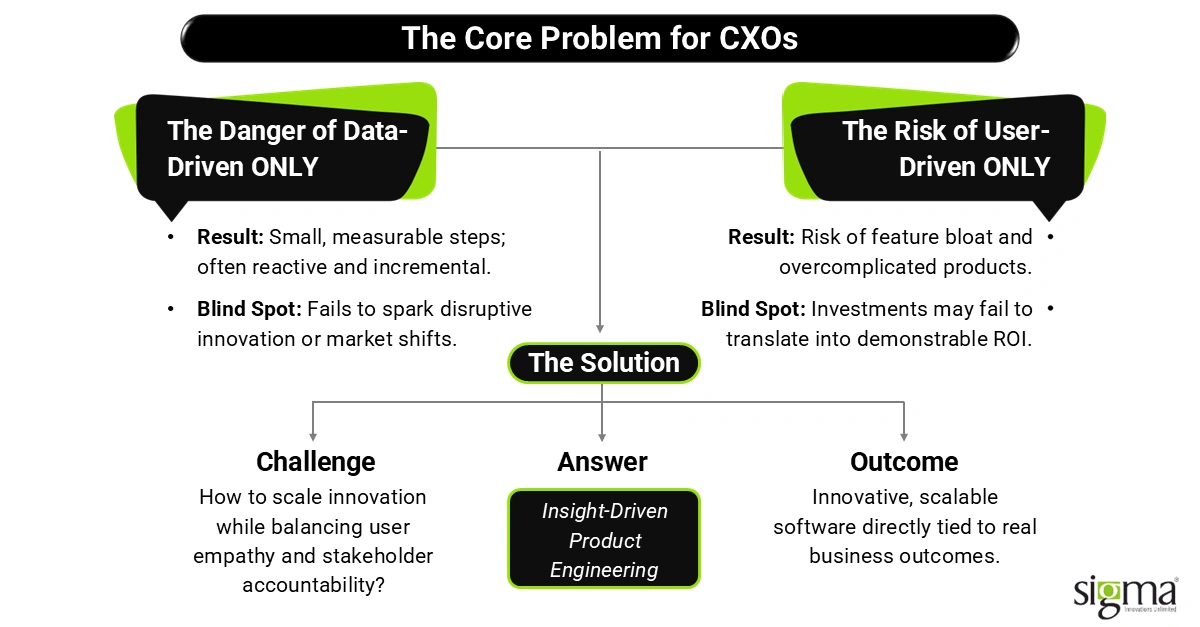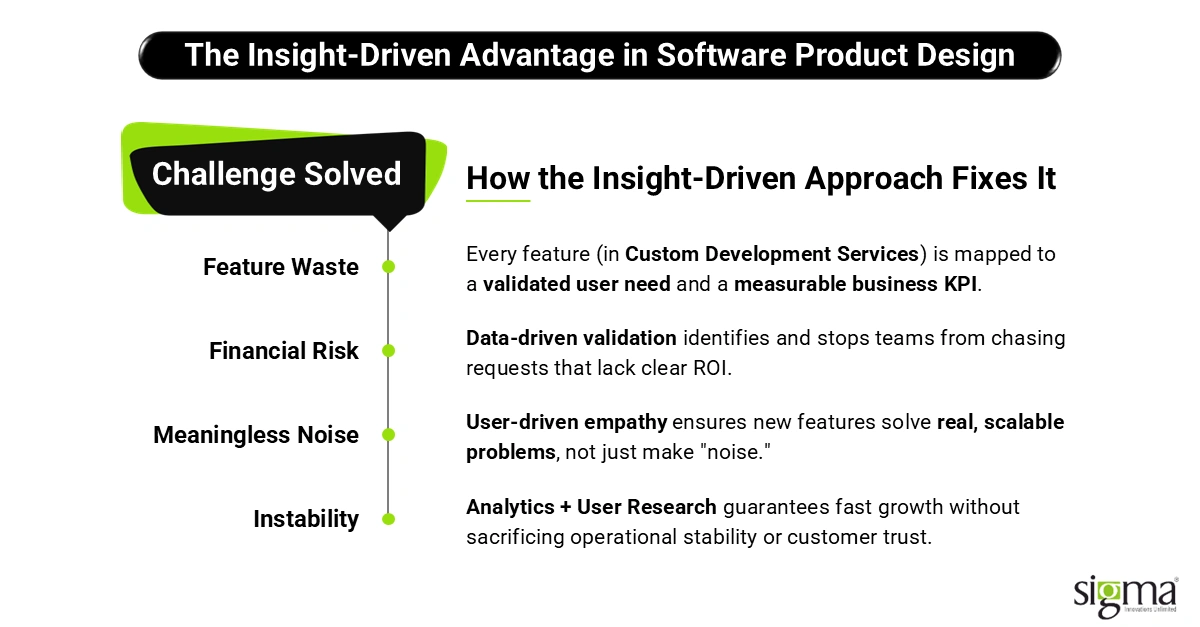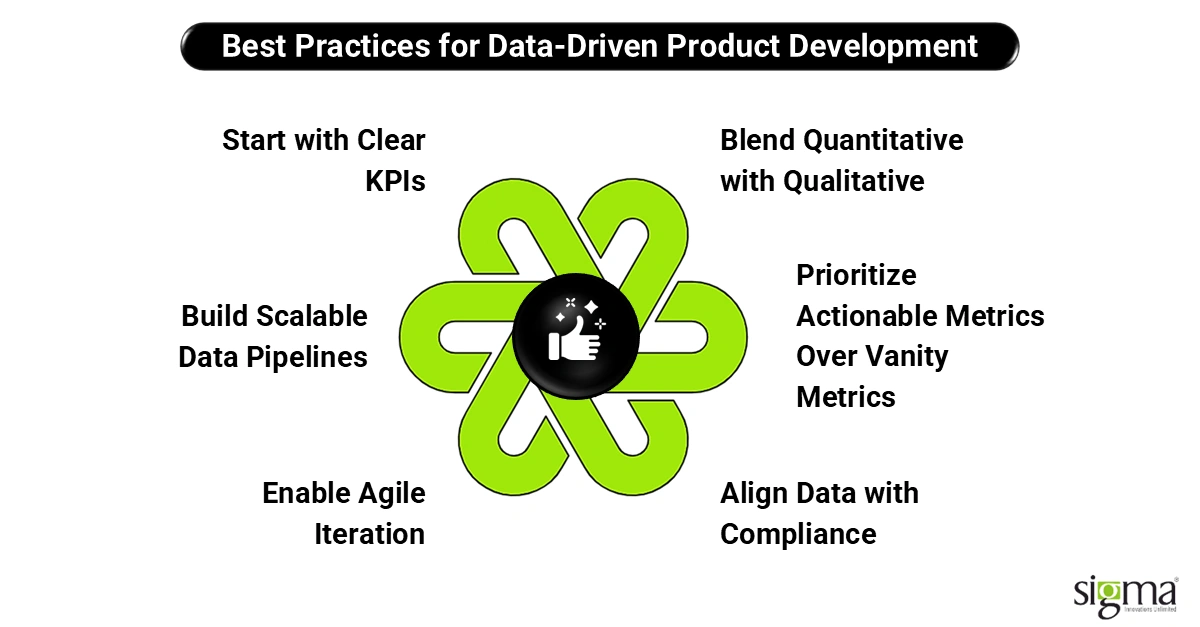Software Product Design: Data Driven vs User Driven

Key Takeaways:
- The Old Tug-of-War: Choosing between data and users is like picking between a compass and a map; you’ll miss the destination without both.
- The CXO’s Dilemma: Data-only teams chase efficiency but miss disruption, while user-only teams innovate but risk burning cash.
- The New Playbook: Insight-driven product engineering fuses empathy with evidence, helping leaders build products that win hearts and markets.
Digital product design still revolves around one fundamental, ongoing debate: should teams rely on data-driven design or follow a user-driven design approach? For years, product managers, UX leaders, and CTOs have leaned one way or the other, chasing metrics on one side or doubling down on customer feedback on the other.
But here’s the truth: in today’s fast-moving Fintech and eCommerce landscape, this debate is outdated. Decision-makers are under pressure to deliver innovation at speed, reduce risks, and generate measurable ROI. Limiting design to only the data or only the user’s voice means you’re operating with only half the map. Data without empathy misses disruptive opportunities. User input without validation can lead to feature bloat and wasted investment.
The winning approach is what we call insight-driven product engineering. This means combining the empathy of user research with the precision of analytics. The “what” and “why” of product design come from listening to users, while the “how” and “when” are validated through data.
At Sigma Infosolutions, we help businesses put this philosophy into action. By blending BI & Analytics development services, software product engineering services, SaaS development services, AI product development services, and custom development services, we create digital product design strategies that are both user-centered and data-backed. The result? Scalable, market-ready products that deliver measurable impact for Fintech and eCommerce leaders.
The Traditional Divide: Data-Driven vs. User-Driven
For years, product leaders have debated which path delivers better results: data-driven design or user-driven design. Each approach has strong merits but also critical gaps when used alone.
Data-driven product design is all about letting the numbers lead the way. Teams rely on metrics, experiments, A/B testing in product design, and predictive analytics to decide what to build next. This approach provides confidence because decisions are backed by evidence. The upside? It scales well and reduces guesswork. The downside? Data usually reflects what’s already happening, so it can miss emerging needs or disruptive opportunities.
On the flip side, user-driven product design focuses on the human side of digital product design. Through user interviews, usability testing, and customer journey mapping, teams uncover pain points and unmet needs. This method fosters innovation and empathy, essential for creating products people actually love. The challenge? Relying only on user feedback can lead to feature overload, long development cycles, and uncertain ROI.
| Feature | Data-Driven Product Design | User-Driven Product Design |
|---|---|---|
| Primary Goal | Optimization, measurable metrics, and quantitative ROI. | Empathy, solving deep user problems, and maximizing satisfaction (UX). |
| Key Question | What is happening? Where are users dropping off? How can we maximize conversions? | Why are users doing this? How can we make this experience better for them? |
| Methods/Inputs | A/B testing, analytics (BI), usage funnels, click-through rates, revenue data, churn metrics. | User interviews, qualitative surveys, ethnographic studies, usability testing, and persona creation. |
| Best for | Optimizing existing features, validating pricing, prioritizing small iterations, and reducing risk. | Identifying new market opportunities, defining the core product vision, and solving complex workflow problems |
| Potential Pitfall | Leads to incremental changes, misses disruptive ideas, and can ignore user frustration that isn’t immediately measurable. | Can lead to feature bloat (“design by committee”) or products that satisfy a small group but aren’t scalable or profitable. |
The insight? Both methods are valuable, but incomplete when pursued in isolation. Data vs. user design shouldn’t be a battle; it’s about combining analytics and user research in product design to create a balanced, future-ready product design strategy.
The Core Problem for CXOs
For many decision-makers, the real problem isn’t choosing between data-driven design or user-driven design; it’s realizing that picking one side alone creates blind spots. In the boardroom, this “choice” mindset is flawed because sustainable growth requires integrated strategies that balance both perspectives.

When companies lean only on data-driven design, they often see measurable results, but only in small steps. Metrics drive incremental improvements, like optimizing a checkout flow or adjusting button placement. While useful, this reactive approach rarely sparks disruptive innovation that moves the market forward.
On the other hand, companies that go all-in on user-driven design run into a different challenge. Listening too closely to customer requests can lead to feature bloat, overcomplicated products, and missed business metrics. Without validation through data, investments may not translate into ROI.
This creates a tough challenge for CXOs, CTOs, and VPs of Product: how do you scale innovation without exposing the business to unnecessary risks? How do you balance empathy for the user with accountability to stakeholders?
The answer lies in shifting the conversation from “either/or” to “both/and.” This is where insight-driven product engineering comes in, an approach that blends the creativity of user-driven insights with the precision of analytics to design software products that are innovative, scalable, and tied to real business outcomes.
Insight-Driven Product Engineering: A New Paradigm
The real breakthrough for modern digital product design isn’t choosing between user-driven design and data-driven design; it’s combining them. This fusion is what we call insight-driven product engineering. It’s about pairing human empathy with measurable validation, so every feature serves both the customer and the business.
At its core, this approach works like a framework:
The “Why” and “What” = User-Driven
User research, interviews, and journey mapping reveal deep pain points, motivations, and aspirations. They answer the fundamental questions: Why does this matter? What should we build?
The “How” and “When” = Data-Driven
Metrics, predictive analytics, and A/B testing in product design provide clarity on how solutions should be implemented and when to prioritize them. They ensure business goals are not only met but also measured.
This balance helps leaders escape the trap of incomplete strategies and move toward sustainable, insight-led innovation.
At Sigma, we bring this philosophy to life by combining our core strengths:
- UI/UX Design Services – to build products rooted in empathy and usability, ensuring the customer experience is intuitive and delightful.
- Software Product Engineering Services – to design scalable, modular architectures that transform insights into real-world solutions for high-volume industries like Fintech and eCommerce.
- BI & Analytics Development Services – to equip leaders with the dashboards, KPIs, and iteration loops they need for data-informed decision-making in product management.
When these services come together, the result is more than just another app or platform. It’s a product design strategy that delivers measurable ROI, reduces risk, and positions companies to compete in fast-moving markets.
Insight-driven product engineering isn’t just a new methodology; it’s a paradigm shift for product leaders who want to balance empathy with evidence and scale innovation with confidence.
Also Read: Why CTOs and CIOs Must Prioritize Custom Tableau Dashboards
Mitigating Risk for Decision Makers (CXO Perspective)
For CTOs, CIOs, and VPs of Technology, building the right digital products isn’t just about innovation, it’s about risk management. Every investment in software comes with questions that go far beyond the code:
“Will this investment deliver ROI?”
Leadership teams need confidence that budget allocations translate into measurable business outcomes.
“How do I avoid sunk costs in the wrong features?”
Too many product roadmaps fail because teams build based on assumptions, not validation.
“How do I balance disruption with stability?”
Innovation is critical, but not at the expense of breaking what already works. CXOs need a product design methodology that protects core operations while enabling growth.
This is where an insight-driven approach to software product design gives leaders an edge:

- Every feature in custom development services is mapped to both a validated user need and a measurable business KPI. No more building features “just because.”
- Data-driven validation prevents waste. Teams can stop chasing requests that don’t translate to ROI.
- User-driven empathy ensures disruption is meaningful. New features don’t just make noise; they solve real problems at scale.
- Balance between stability and innovation. By combining analytics and user research in product design, CXOs can move fast without breaking trust.
At Sigma, we specialize in creating these frameworks for SaaS development services and high-stakes Fintech platforms. Through our software product engineering services, AI product development services, and BI & Analytics development services, we help decision-makers build systems that innovate responsibly, adapt quickly, and scale confidently.
For leaders, this means fewer sleepless nights over sunk costs and more confidence that every product decision is a step toward both user satisfaction and business growth.
Best Practices for Data-Driven Product Development
Data-driven product development isn’t just about collecting numbers; it’s about making smarter, faster decisions that align with both user needs and business outcomes. Done right, it gives product teams the clarity to prioritize features, cut waste, and accelerate time-to-market. Done wrong, it leads to data overload, chasing vanity metrics, and missing the big picture.
To keep your strategy sharp, here are some best practices that decision-makers in Fintech and eCommerce should follow:

- Start with Clear KPIs: Define what success looks like before the first experiment. Whether it’s reducing cart abandonment in eCommerce or improving loan approval rates in Fintech, anchor your efforts to measurable outcomes.
- Blend Quantitative with Qualitative: Numbers show what is happening, but user research explains why. Pair A/B tests and funnel analytics with interviews and usability testing for a 360° view.
- Build Scalable Data Pipelines: Ensure your product engineering supports real-time data capture, transformation, and reporting. Modern BI dashboards (Power BI, Tableau) give CXOs a cockpit view for quick decisions.
- Prioritize Actionable Metrics Over Vanity Metrics: Focus on signals that drive business impact like conversion rate, feature adoption, and ROI per feature rather than surface-level stats like page views.
- Enable Agile Iteration: Treat every release as a learning opportunity. Feed insights from data back into the design loop so products evolve continuously instead of stagnating.
- Align Data with Compliance: In regulated industries like lending and payments, compliance frameworks (PCI DSS, SOC2) must be baked into your data-driven workflows from day one.
Data-driven product development is like using headlights on a dark road; you still need a sense of direction, but without the illumination of insights, you’re driving blind. Pairing solid data practices with user empathy helps leaders innovate without guessing, mitigate risks, and deliver products that truly resonate with the market.
The Engine: BI, AI, and Product Engineering
The real power of insight-driven product engineering lies in the technology engine that makes it possible. For CXOs, it’s not enough to say, “We’ll listen to users and validate with data.” You need the right architecture, tools, and services to bring that strategy to life. At Sigma Infosolutions, this engine is built around four pillars: BI & Analytics development services, AI product development services, product engineering services, and custom development services.
BI & Analytics Development Services
Every click, tap, or transaction generates a trail of data. But raw data by itself is noise. BI & Analytics development services transform these user events and transaction records into actionable insights.
Take Fintech lending platforms as an example. By analyzing application data, lenders can pinpoint where users drop off in the loan origination journey. Are borrowers abandoning the process because of confusing forms? Or because credit-check APIs are too slow? With tools like Power BI and Tableau dashboards, decision-makers get real-time visibility into bottlenecks and can act quickly.
This isn’t just reporting; it’s how data influences software design decisions. It helps CXOs optimize both user experience and business performance in measurable ways.
AI-powered Product Development
Where BI tells you what happened, AI predicts what will happen next. With AI product development services, companies move beyond descriptive analytics to predictive design.
- In Fintech, AI/ML models flag suspicious activity in real time, strengthening fraud detection while protecting trust.
- In eCommerce, AI personalizes product recommendations before customers even search, boosting engagement and conversion rates.
The real advantage lies in training models that serve both UX and ROI. Imagine a product design methodology where the system anticipates needs before users articulate them. That’s data-informed decision-making in product management at its peak.
Software Product Engineering
Even the best insights fail without the right infrastructure. That’s where software product engineering services come in.
Our teams design and build:
- Data pipelines that capture every meaningful signal.
- APIs and microservices that integrate systems across cloud and enterprise.
- Compliance-ready architectures that meet PCI DSS and SOC 2 standards are critical for SaaS and Fintech leaders.
The real power? Agility. With product engineering services in the USA, companies can close the feedback loop: user insights feed into data pipelines, which guide iteration, which in turn generate fresh data for BI and AI models. This creates a continuous improvement cycle that keeps products relevant and competitive.
Custom Development
Sometimes, packaged SaaS solutions aren’t enough. That’s where custom development services step in.
- A niche business lender might need a bespoke loan management platform with built-in AI underwriting.
- An eCommerce retailer could require a tailored Adobe Commerce solution integrated with AI-driven personalization to stand out in a crowded market.
These solutions go beyond templates; they deliver true differentiation. By aligning user-driven insights with data-driven validation, custom development in the USA ensures products don’t just fit industry standards, but set them.
In short, the engine behind insight-driven product engineering combines four forces:
- BI gives leaders clarity.
- AI delivers foresight.
- Product Engineering builds the foundation.
- Custom Development ensures differentiation.
Together, they create a product design strategy that’s scalable, secure, and built for long-term ROI, exactly what CXOs in Fintech and eCommerce demand.
Also Read: US FinTech Market Growth, Trends, and Forecast
Case-in-Point: Industry Scenarios
The value of Insight-Driven Product Engineering comes alive when applied to real-world challenges. By fusing user empathy with data-backed validation, organizations can translate abstract goals into measurable business outcomes.
Fintech Example: Lending SaaS Platform
- User-Driven Insight: Through user interviews, the product team learns that borrowers frequently abandon the loan application process due to friction. The frustration is most pronounced during the income verification stage.
- Data-Driven Validation: Analytics confirms the issue that 45% of applicants drop off exactly at the verification step. This hard evidence quantifies the scale of the problem and prioritizes it over other assumptions.
- Insight-Driven Solution: The team builds a seamless document-upload microservice powered by AI-driven validation. This reduces user effort while improving accuracy and compliance. The outcome? A significant lift in loan application completion rates and a measurable ROI for the platform.
eCommerce Example: Adobe Commerce at Scale
- User-Driven Insight: Mid-market retailers express frustration about how long catalog management takes, with store managers highlighting repetitive manual tasks as a major pain point.
- Data-Driven Validation: Business intelligence dashboards reveal the hidden cost, 60% of operational time is consumed by catalog updates, creating bottlenecks and delaying time-to-market.
- Insight-Driven Solution: By integrating AI-based catalog enrichment within Adobe Commerce, repetitive tasks are automated, product metadata is enhanced, and store teams reclaim valuable time. This translates into operational efficiency and the ability to scale without linear increases in headcount.
These scenarios demonstrate the holistic nature of Insight-Driven Product Engineering. Empathy uncovers the “why,” analytics confirms the “where” and “how big,” and engineering translates insights into solutions that move the needle. Whether in fintech or eCommerce, the approach ensures technology investments are not just functional, but transformational.
Why Insight-Driven Software Product Design is the Future
In today’s digital economy, market leaders are no longer debating between user-driven empathy and data-driven validation. The real differentiator lies in fusing both into a single, systematic approach, which we call Insight-Driven Product Engineering.
Rather than just listening to users or testing hypotheses in isolation, this model engineers insights directly into the product lifecycle. That means every feature, every architecture choice, and every release is tied back to a proven user need and a measurable business KPI. The result is not just functional software, but market-ready solutions that outperform the competition.
The Competitive Edge of Going Insight-Driven:
- Faster Innovation Cycles: By balancing qualitative empathy with quantitative proof, product teams cut down on wasted iterations and accelerate time-to-market.
- Higher ROI per Feature: Investments focus only on what users truly need and what delivers business value, reducing the risk of sunk costs.
- Scalable Growth in High-Stakes Sectors: Especially in Fintech and eCommerce, where compliance, customer trust, and rapid iteration are non-negotiable, Insight-Driven approaches enable growth without sacrificing stability.
This shift isn’t just theoretical; it’s becoming the new standard. Companies that continue to rely solely on intuition or only on raw analytics risk falling behind. Competitors who adopt Insight-Driven Product Engineering will consistently deliver smarter, faster, and more scalable solutions.
At Sigma, we bring this paradigm to life through:
- UI/UX Design rooted in empathy.
- Product Engineering Services that deliver modular, scalable, and secure systems.
- BI & Analytics that create executive-ready dashboards for decision-making.
- AI Development that anticipates needs before they surface.
The future belongs to insight-driven organizations. Partner with Sigma Infosolutions to build products that don’t just work but help you win and gain a competitive advantage.
Conclusion
The long-standing debate between data-driven design and user-driven design is no longer relevant. The fast-paced digital economy demands a partnership where quantitative data validates and empowers qualitative human insight. The companies that succeed are those that integrate both perspectives into their product lifecycle.
Insight-driven product engineering is the true north for Fintech and eCommerce leaders. By combining qualitative research with quantitative validation, organizations can build products that delight users, generate measurable ROI, and scale sustainably. Every feature is intentional, every release backed by insight, and every decision tied to business outcomes.
At Sigma Infosolutions, we help decision-makers bring this vision to life in the USA through:
- BI & Analytics Development Services – actionable dashboards and real-time insights.
- AI Product Development Services – predictive models to anticipate user needs.
- Product Engineering Services – scalable, secure architectures.
- SaaS & Custom Development Services – tailored solutions for high-stakes platforms.
Decision-makers ready to future-proof their product strategy should partner with Sigma Infosolutions. Transform your software product design in the USA into an insight-driven engine for growth, innovation, and competitive advantage.
